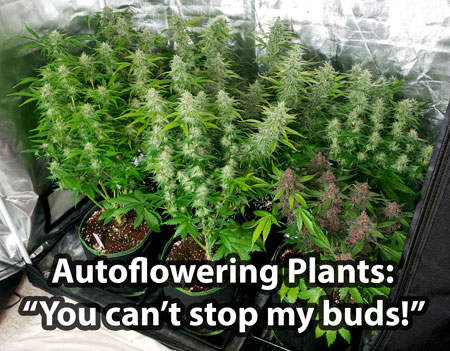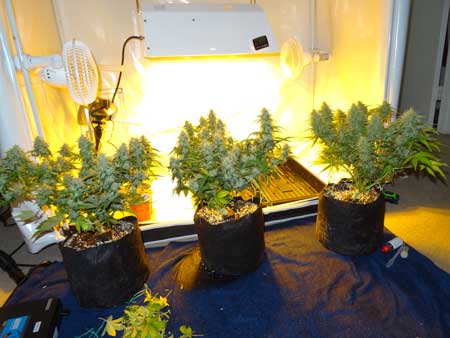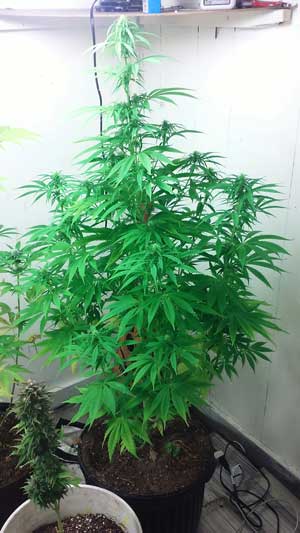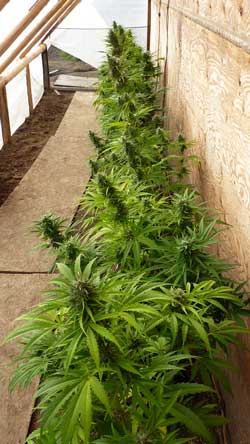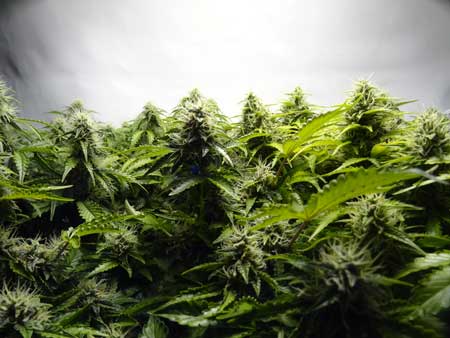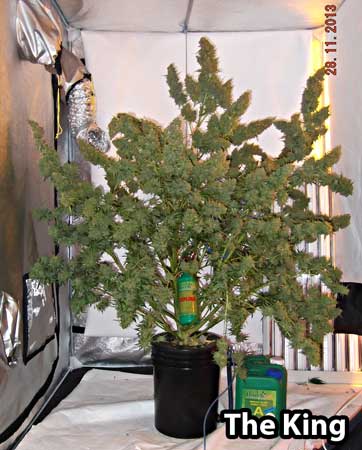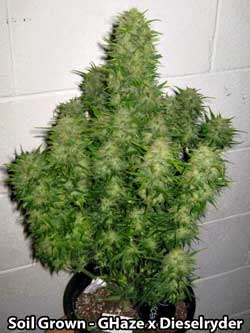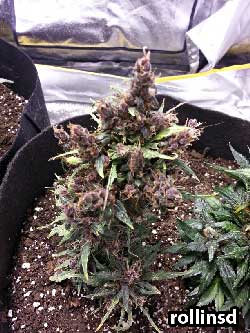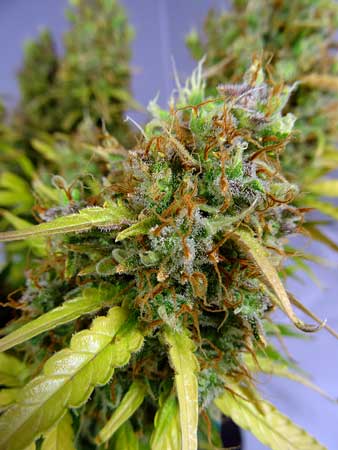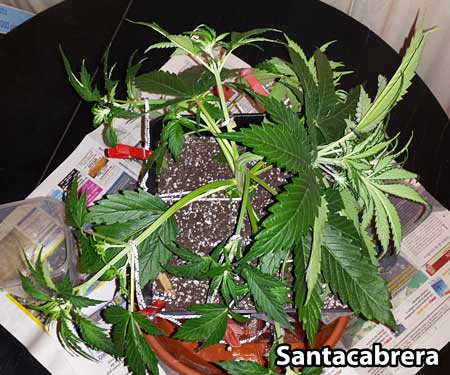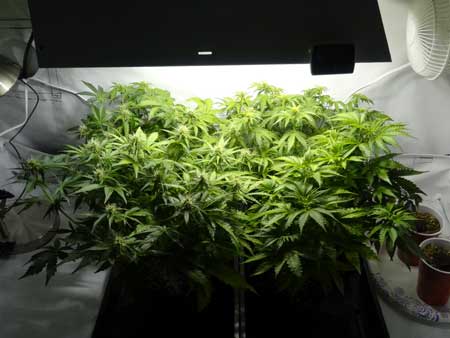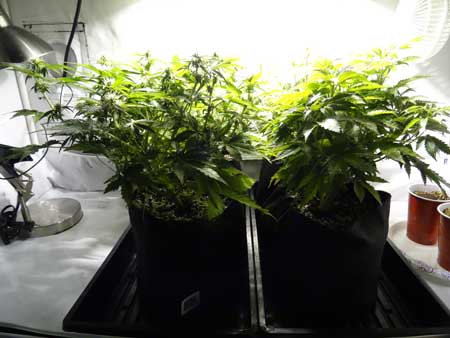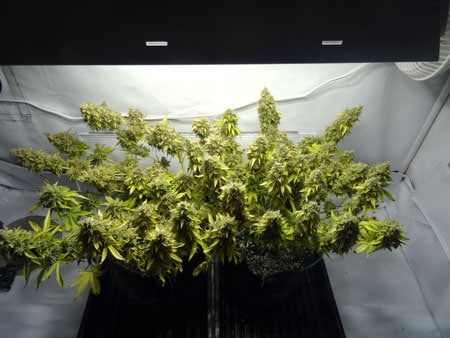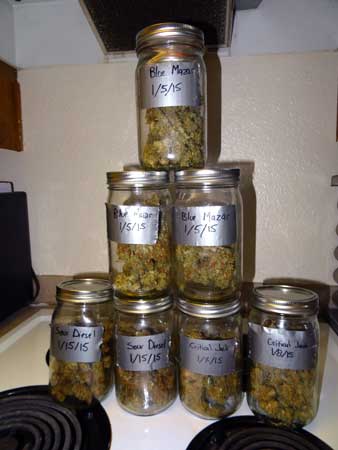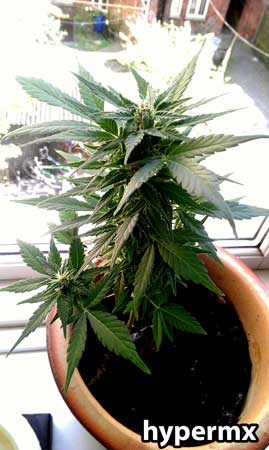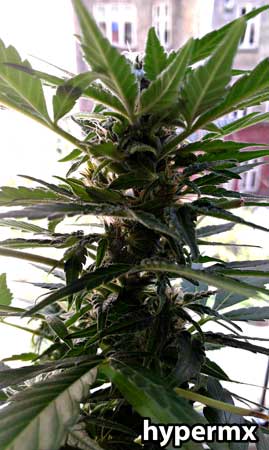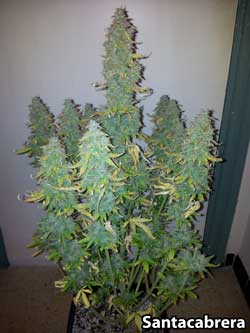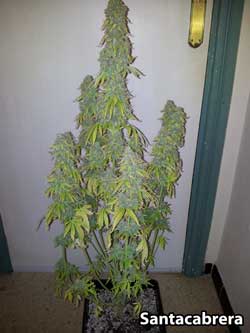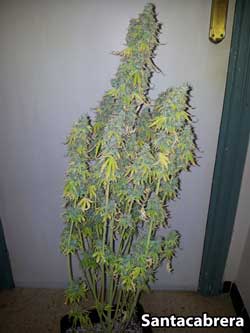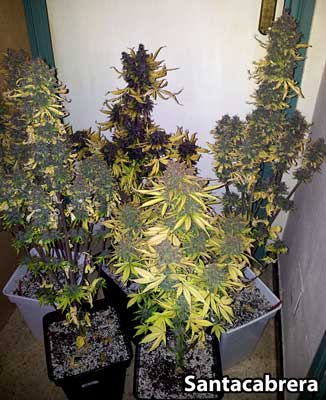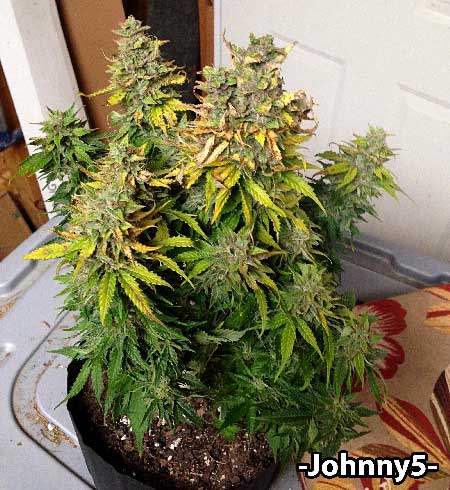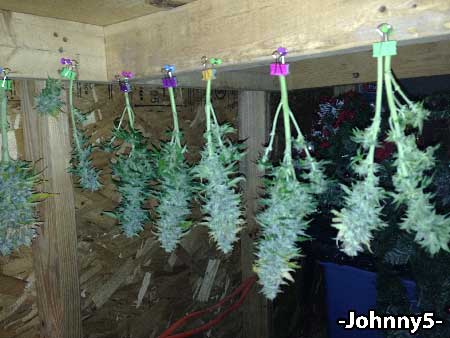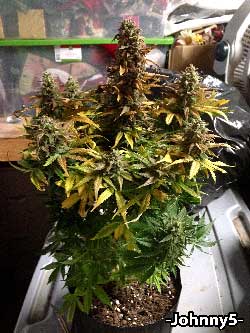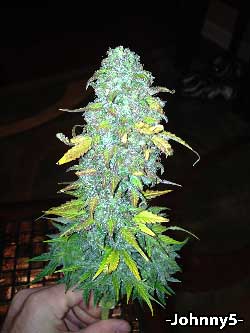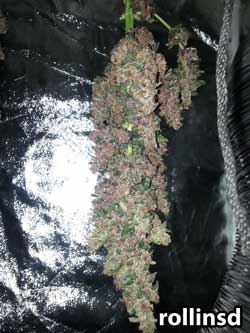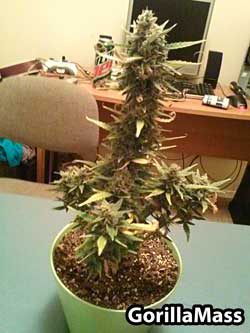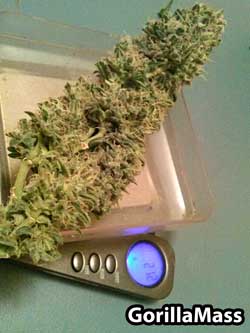by Nebula Haze & Sirius Fourside
Table of Contents
Introduction to Auto-Flowering Cannabis Strains
Auto-Flowering vs Traditional (Photoperiod) Cannabis Strains
So, You Want to Grow an Auto-Flowering Plant?
Which breeders make the best auto-flowering strains? <— Recommended breeders
Pictures of Auto-Flowering Plants – What do they look like at harvest?
Introduction to Auto-Flowering Cannabis Strains
Auto-flowering cannabis strains are the descendants of a wild strain of hemp first identified as “Ruderalis” in Russia during the early 1940s.
These are different from most strains of cannabis, which are known as “photoperiod” strains. Photoperiod plants don’t start flowering (making buds) until they get specific signals from the sun that winter is coming, so need special light schedules to be induced into making buds.
Conversely, Ruderalis plants don’t need any type of signal. Instead, Ruderalis plants start flowering when they reach 3-4 weeks of age no matter what’s going on with the sun or light schedules, and their buds are ready to harvest only a few months from seed.
Auto-flowering marijuana strains start automatically making buds (flowering) when they’re 3-4 weeks old. On average, plants are ready to harvest 2-3 months from germination. Sometimes as little as 55 days!
By living such a short life, Ruderalis cannabis plants were able to survive in Russia with short summers and extremely long winters. Unfortunately, just like other types of wild hemp, wild Ruderalis buds contain very low levels of THC. Wild Ruderalis plants were also very small and produced tiny amounts of bud, which might make them seem useless to cannabis growers.
Fortunately, a forward-thinking breeder realized that the auto-flowering capability and short growing period of Ruderalis strains might be useful to hobbyist cannabis growers, even though the wild Ruderalis plant wasn’t going to work all by itself. This unknown breeder started intermingling Ruderalis plants with famous strains of photoperiod (regular) cannabis in order to increase bud potency while carefully breeding plants to retain the auto-flowering capability.
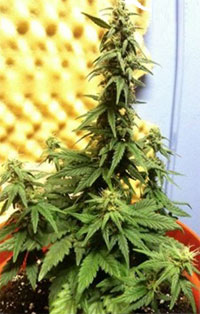
The best modern auto-flowering cannabis strains have been bred to produce bigger and denser buds than the original Ruderalis plants. Buds have also been bred to be as potent as photoperiod strains.
Genetics Make a Huge Difference with Auto-Flowering Cannabis Strains
The original Ruderalis ancestors stayed small and weren’t potent, as were the original auto-flowering strains, so the breeding history of an auto-flowering strain is crucially important.
As breeders have been able to make more specialized strains, they’ve tailored the effects and growth patterns for different needs and purposes. As a result, each strain grows differently, just like with photoperiod strains. That’s why it’s always a good idea to read the breeder’s description of a strain when buying seeds. Some auto-flowering strains get particularly tall, while others tend to stay short. You’ll get the best results if you match your strains to both your setup and each other!
These two auto-flowering plants are the same age and were grown in the same setup! Genetics makes a huge difference to your final results, so it’s important to pick the right auto-flowering strain for your goals! The small plant is White Widow Auto & the huge plant is Onyx Auto. The difference between different auto-flowering genetics is hard to overstate.
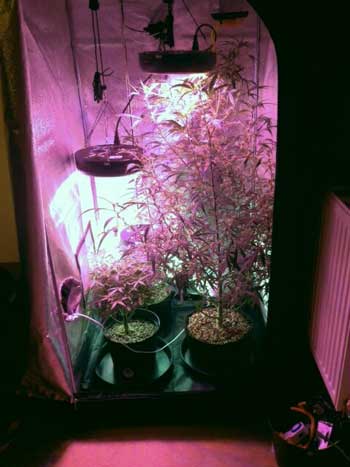
The following two autoflowering plants are also the same age (70 days from germination) and grown in the same environment. One plant stopped growing and started making buds after just a few weeks, resulting in a tiny plant with one bud that is just about ready to harvest already. The other plant kept growing for almost 2 months before budding in earnest, which means the plant is far bigger but the buds still need a lot more time before they’ll be ready to harvest.
These two auto-flowering cannabis plants are also the same age and grown in the same environment! The small plant on the lower left is Auto Chemdawg (can you spot it?) while the huge plant dominating the picture is Super Lemon Haze Auto.
Auto-flowering pic by henry tate
I hope these two examples help show why it’s important to get the right auto-flowering strain for your goals and setup! If you want a small, fast plant you won’t be happy with your results if you purchase a tall strain, or vice versa.
Because of their short vegetative stage and lifespan, in general most auto-flowering cannabis strains tend to stay relatively short, and are ready for harvest around 3 months from germination.
The really exciting part is the auto-flowering world is evolving quickly. More and more breeders continue making new auto strains. We’re starting to see better and better yields, more nuanced potency, and a lot more variation when it comes to harvest times, plant size and growth rates.
Auto-Flowering vs. Traditional Cannabis Strains
Unlike traditional (referred to as photoperiod) cannabis strains, autos don’t need any special kind of light schedule to “tell” the plant to start budding. With a photoperiod strain, a cannabis plant needs 12+ hours of darkness a day to initiate flowering.
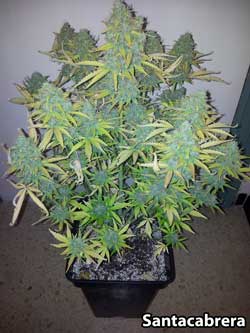
Indoor growers cultivating photoperiod strains can initiate flowering at will by giving plants longer dark periods (usually by putting their grow lights on a timer). For indoor growers, this means the grower needs to make a light-proof grow space to allow for 12 hours of uninterrupted darkness each day while the plants are flowering.
For an auto-flowering cannabis plant, a grower doesn’t have to worry about light schedules. Each auto-flowering plant starts blooming after a few weeks no matter what light schedule is provided. For outdoor auto growers, there’s no need to match up the strain with your local time zone or plant at the perfect time – simply plant autos when you know you have at least 2-3 months of warm, sunny weather.
When growing auto-flowering plants outdoors, you don’t need to worry about light schedules. You just need to ensure your plant will have 3 months of warm weather (above 60°F) and your climate is likely suitable to grow auto-flowering plants. These auto-flowering cannabis plants were ready to harvest before summer was even over:
For all growers in a hurry to harvest, an auto-flowering plant will almost certainly be ready to harvest more quickly than any other type of cannabis strain.
Auto-Flowering Cannabis Strains
Generally, cannabis autos are ready to harvest sooner than photoperiod plants. Most autos are ready to harvest 2-3 months after being sprouted from seed.
For the first few weeks, autos (auto-flowering plants) only make vegetative growth – stems and leaves. After their short “vegetative stage” ends, the plant will start making buds and continue to grow taller even while their buds are forming.
It’s only a few weeks before harvest that most auto-flowering plants stop growing “up and out.” At this point, auto-flowering plants put all their energy into fattening buds, and buds can gain substantial weight during the last few weeks.
When purchasing auto seeds, good breeders will be able to tell you how long the strain will take until harvest. It’s important to note that most strain breeders will tend to provide the shortest time frame they can, and many autos will produce better yields and higher potency if left for a week or two (sometimes even three) longer than recommended.
How do I know when to harvest my plants? – Basically, in addition to the visual appearance of buds, you can look at your buds under a magnifier to know exactly when to harvest for top THC potency.
Photoperiod Strains
Photoperiod strains usually take longer to harvest than autos. In general, photoperiod strains are ready to harvest 3-4+ months after being sprouted from seed, though the final time depends heavily on your grow style and which strain you choose. Even photoperiod plants flowered from seed tend to take longer than an auto-flowering plant to be ready to harvest, and the yields are much lower. Photoperiod plants do best when given some time in the vegetative stage before they start flowering, and aren’t as well suited to quick harvests.
Learn more about how long it takes to grow cannabis plants
Auto-Flowering vs Photoperiod: Which Yields More?
Auto-Flowering Strains
Autos generally yield up to about 4 ounces of bud per plant when taken care of throughout their life, but the amount of bud produced has a lot to do with the grow setup.
Many growers end up yielding 1-2 ounces per auto or even less, especially if starting with poor genetics or when using a sub-par lighting setup. Like all cannabis plants, autos need a lot of light to produce good yields!
In some cases, growers with a lot of experience, great starting genetics and perfect conditions can yield up to 6 ounces per auto-flowering plant or more.
For example, this indoor Dutch Passion AutoMazar plant yielded above 900g (more than 30 ounces of dried bud) from just one plant under about 1000W worth of light. Normal yield for this strain is about 100g, so this – admittedly extreme example – demonstrates what a great setup and grow experience can do for your yields!
When considering yields, it’s important to remember that one of the advantages of growing auto-flowering cannabis strains is most growers can produce several harvests a year (since the lifespan of each auto plant is very short).
See auto strains recommended by experienced auto growers
Photoperiod Strains
Photoperiod strains can have a lot more variation in yields than auto-flowering plants. This is due to the fact that photoperiod growers have a lot more control over the size and shape of the plant, which in turn has a huge effect on yields.
Outdoors, your yields depend a lot on your climate. Warm and sunny weather with many hours of light a day will produce plants with bigger yields.
Indoors, generally, your setup is the biggest determining factor of your yields.
Learn more about indoor setups and what types of yields to expect
5 ways to increase yields indoors (with any strain)
Which is more potent? What about smell and taste?
While there are currently fewer auto-flowering strains to choose from, the potency for autos and photoperiod cannabis plants is comparable. Auto-flowering buds are not significantly less potent.
However, one major difference is that many auto-flowering strains tend to have higher amounts of CBD in their buds than photoperiod strains (because Ruderalis plants are high-CBD). CBD is a cannabinoid that is known for having medical properties as well as reducing anxiety.
But in general, a modern “Blue Cheese” auto has been bred to have similar bud characteristics as a “Blue Cheese” photoperiod plant.
The autoflowering breeding scene has come a long way since the original low-potency “Lowryder” auto plants!
Smell, Taste, and Visual Appeal – When it comes to smell & taste, the same rules apply. While there are fewer auto-flowering strains to choose from (though the list is growing each day), the smell and taste of modern autoflowering strains are similar to their photoperiod counterparts.
Learn how to improve the smell & taste of your buds
The one visual difference I’ve seen is that auto-flowering buds tend to be a little bit leafier (grow more leaves among the buds) than photoperiod strains, which means they may need a little extra care during trimming to get rid of all the leaves.
It’s important to note that some photoperiod strains grow in the same way, and I don’t believe that extra leaves during the budding process is necessarily a bad thing. If anything, the extra leaves seem to power the growth of buds, causing them to swell up more in a smaller amount of time and in less light than photoperiod strains.
Are auto-flowering strains better for medical marijuana?
An important characteristic for medical marijuana patients is that auto-flowering buds tend to contain higher levels of CBD than photoperiod strains.
CBD is a cannabinoid that is known for having medical and anti-anxiety properties. Most photoperiod strains these days are high THC and low CBD. It can be hard to find high-CBD photoperiod strains, though luckily that market is much better than it used to be. Learn more about THC vs CBD.
This makes auto-flowering buds an attractive choice for some medical marijuana patients who are looking for higher CBD cannabis strains. There are also auto-flowering strains that are bred principally to be high in CBD. It’s difficult for many growers to get clones of one of the famous high-CBD photoperiod strains, and auto-flowering strains can make it easier for some patients to get access to CBD.
When I grew auto-flowering strains, the buds felt more medicinal (as opposed to recreational) than the majority of strains I’ve grown. Even in higher doses, the effects weren’t as “racing” as some of the really high-THC, low-CBD strains. The buds all made me feel very pleasant and helped melt away stress, without being overwhelming. I think some people might actually prefer the effects of auto-flowering buds, even if they’re not patients, and I believe autos may be a great choice for some medical marijuana patients.
How big will each cannabis plant get?
Auto-Flowering Strains
Autos tend to stay short naturally. In fact, in most conditions it is difficult to produce very large auto-flowering plants because they have such a short lifespan. They only grow bigger for about 1-2 months. The rest of their lives are spent fattening buds.
On average, autos grow 1-4 feet tall by harvest time; generally, auto-flowering plants will stay under 4 feet in height. The final height of each auto depends a lot on the strain you choose and whether you provide enough light. You can also use some non-stressful plant training methods like bending tall branches over (low stress training) to help prevent stretchy autos from getting too tall.
More tips on training auto-flowering strains to grow how you want
Photoperiod Strains
There are differences in how photoperiod plants grow, which are most pronounced in the flowering stage. For example, some photoperiod strains grow faster or with longer branches than others, but with a little creativity, cannabis photoperiod strains can be trained to grow into almost any size or shape.
Learn about the most common ways to train cannabis plants.
Do autos need a special light schedule to start making buds?
Do auto strains need a special light schedule? In a way, yes!
Autos Should Get 18-24 Hours of Light a Day for the Best Yields
Why are light schedules important anyway?
Auto-Flowering Strains
Auto-flowering strains will automatically start flowering (making buds) after around 3-4 weeks, a time period dependent on the specific strain. You cannot change this; autos will automatically start flowering due to an internal countdown. After they start making buds, they will stay in the flowering stage until harvest time. Harvest is usually 2-3 months from seed and depends almost completely on the strain.
Therefore, with auto-flowering plants, there is no special light schedule “needed.” The grower does not need periods of darkness to initiate the flowering stage and get plants to bud properly. You can grow an auto-flowering plant from seed to harvest even if you were giving just 12 hours or even 8 hours of light a day and it will still make buds and be ready to harvest. However, to get the best yields you want to take advantage of the fact that you can give autos a lot of light each day since more light each day = more growth = bigger yields.
One advantage of this internal timeclock is that auto-flowering strains can be grown outdoors in a city environment where the ambient light at night may be too bright for photoperiod plants to be able to make buds. Autos don’t care if they’re exposed to light at night. This can also be used in warm climates to get plants to grow outside the normal growing season. For example, as long as it’s warm enough you could start a plant in April outside and it will be ready to harvest by July, which is much sooner than you’ll be able to harvest any photoperiod plant (all of which are ready to harvest in mid to late Fall).
Note: The auto-flowering internal clock is why it’s recommended to never take clones from auto-flowering strains – clones will be on the same time clock as their mother. Learn more about why it’s not recommended to take clones from auto-flowering plants.
Photoperiod Strains
Photoperiod strains need to be on a 12-12 light schedule to initiate flowering. When growing outdoors, photoperiod plants naturally start making buds as winter approaches and days grow short. However, most indoor growers put their grow lights on a timer to initiate and maintain a 12-12 light schedule during the flowering stage until harvest. This need for uninterrupted darkness is why it’s important to create a light-proof growing environment when growing photoperiod plants indoors.
The term “12-12” stands for 12 hours of light and 12 hours of dark each day, and it “tells” photoperiod plants to enter the flowering stage and make buds. During their daily dark period, photoperiod plants need to receive complete darkness without interruption. This light schedule initiates flowering and must be maintained throughout the entire flowering stage until harvest.
If photoperiod plants receive too much light each day or are exposed to light during their dark period, they will either produce hermies (bad) or revert back to the vegetative stage (stop making buds). If you will be unable to provide complete darkness to your plants during their night period, it’s recommended that you choose to get an auto-flowering strain, which isn’t affected by light at night.
Auto-Flowering Strains
In some ways, auto-flowering strains are more simple to grow than photoperiod strains, but there are some additional considerations. For example, autos do poorly if the grower runs into major problems during the beginning of the grow because an auto jumps straight into the flowering stage even if it’s not doing so hot.
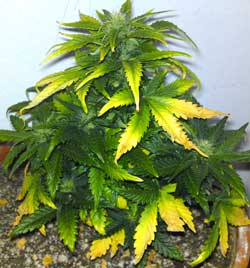
Autoflowering strains begin making buds and continue on their short internal time clock regardless of their health. If you make a lot of mistakes, you will not have time to remedy the plant and you may end up with a small stunted plant.
On the flip side, if your autoflowering marijuana grow doesn’t go as well as planned, at least it will be harvest time in just 2-3 months, you’ll learn a lot, and you’ll have the opportunity to try again. That being said, autos are essentially very simple and a first-time grower can easily get a great harvest on their very first grow. Plus, auto-flowering plants (and cannabis plants in general) are hardy! As long as you give them basic care, they will reward you!
Photoperiod Strains
Photoperiod plants are able to recover from major growing problems in the vegetative stage when grown indoors because the grower can give the plants as much time as needed to recover before switching plants over to the flowering stage.
In some instances, photoperiod strains of cannabis may be easier to grow indoors if you are a new grower because you can give yourself as much time as to fix problems in the vegetative stage. During this stage, cannabis plants are hardy and can easily bounce back from problems. Even if you make a lot of mistakes, you can still get big yields because unlike with autoflowering strains you are in control of when the flowering stage begins.
Once the flowering cycle is initiated, your plants are more “set” as far as their overall health and structure. Once a cannabis plant starts budding, there is basically a countdown until buds are ready to harvest just like autos (this amount of time is mostly based on the strain). Though the plant may have an initial last “stretch” of vegetative growth when the light cycle is first changed over, as the plant approaches harvest towards the end of the flowering stage, almost all growth halts except for the development of bigger buds.
Are autos better for growing outdoors?
Auto-Flowering Strains
Auto plants are suitable for growing outdoors in almost any climate that has at least 2-3 months of warm, sunny weather every year.
Requirements for growing auto-flowering strains outdoors are pretty simple…
- Lots of direct light each day. Auto plants should receive 5+ hours of direct light each day. More is better. In general, more light = bigger yields.
- 2-3 months of warm, sunny weather. When planting seeds, you should ensure that the weather will stay warm and sunny for at least 2-3 months from when the seed is first planted.
Photoperiod Strains
When growing photoperiod plants outdoors, it’s important to make sure you plant your seeds at the right time and choose a strain that is suitable for your climate.
When growing photoperiod strains outdoors…
- Plant in Spring. Photoperiod plants need to be planted outdoors in late Spring after days have grown long enough to support a vegetative stage. It’s safe to put plants outside in late April for the Northern Hemisphere, and late October for the Southern Hemisphere.
- You can start plants indoors. Photoperiod plants can be started indoors if it’s too cold to put plants outside during your spring, or if you would like to grow bigger plants than would normally be possible in your local environment. Just make sure indoor plants get at least 14+ hours of light each day.
- Choose the right photoperiod strain for your climate. A strain suited to your environment needs to be chosen with your climate in mind to ensure that buds are ready to harvest before winter. What this means is you need to ensure the strain’s “flowering stage” is short enough for your climate. The length of a photoperiod strain’s flowering stage is primarily determined by genetics; outdoor photoperiod plants will start flowering when days grow short as winter approaches. It’s important that you choose a strain with a flowering period short enough to allow buds to mature before it gets too cold or rainy. Cannabis plants cannot survive freezing temps or torrential rain, so you need to choose a strain that will be ready to harvest before winter sets in. Generally, “Indica” strains have a shorter flowering stage and are more suited to colder climates with short summers. “Sativa” strains are more likely to have longer flowering stages and are better suited to warm climates with long, sunny summers.
- Make sure photoperiod cannabis plants are not exposed to light during their night period. When growing photoperiod plants outdoors, being exposed to light at night can prevent them from flowering, or cause them to have other problems. While moonlight or starlight won’t bother your plants, it’s important they’re not grown near spotlights, street lights, or other bright sources of light at night.
Can I use plant training methods on cannabis auto-flowering strains?
Can I Top an Auto? (full article with instructions)
Auto-flowering strains respond well to very light low stress training (LST) such as bending the plants to “open up” lower branches to light.
Bend too-tall branches down and away from the center of your auto weed plant
Plant training is a tactic that helps cannabis growers increase yields indoors by exposing more buds to strong, direct light from the grow light.
When training autos, the idea is to use bending to open up the plant so it grows flat and wide
A view from the side so you can see how those plants were trained to grow flat and wide
Training allows all the bud sites to grow directly under the light, so they get as big as possible
See the full grow journal with these autos
Many growers do not recommend exposing autos to plant training methods that involve cutting the plant (topping, FIMing, main-lining, etc.) as the autoflowering vegetative stage is short and plants often don’t have enough time to recover before they begin flowering.
Because of the quick time schedule, it is important to avoid stressing auto-flowering plants during their grow because the plants don’t have time to recover from problems.
However, when plants are fast-growing and healthy, many growers defoliate, top or FIM their plants with great results. When is it okay to top an auto?
More tips on growing autos below
Photoperiod Strains
Since photoperiod cannabis plants can be forced to remain in the vegetative stage for as long as the grower wants, a grower can take advantage of a variety of plant training methods to shape/train the plant during the vegetative stage, including LST, topping, FIMing, main-lining, ScrOG, etc.
Training methods along with a properly timed light schedule can be used to produce very small or very large plants…whatever the grower wants!
Learn more about cannabis training techniques here
Can I clone auto-flowering plants?
Auto-Flowering Strains
A clone is when you take a cutting of a plant and allow the cutting to grow into its own plant. Autoflowering cannabis plants cannot be cloned effectively because new clones are on the same internal “time clock” as their mother, and therefore any clone taken from her will die when she dies.
Because of this, auto-flowering clones live short lives and most growers strongly recommend against cloning auto strains because they stay extremely small and will not live long enough to produce good yields.
While autos can’t be used to make clones, it is possible to make seeds using a male to pollinate a female auto-flowering plant.
Photoperiod Strains
Photoperiod plants can be cloned, which means that a grower can continue to make more and more plants from a single seed. Cloning is a great way to get unlimited free plants which are almost exactly the same as each other.
So, You Want to Grow an Auto-Flowering Plant!
Which breeders can I trust for good auto-flowering seeds?
Which breeders can I trust for good auto-flowering seeds? These auto breeders have dedicated themselves to developing auto-flowering strains in particular, and have gained popularity for their consistency and quality.
Some Excellent Auto-Flowering Cannabis Breeders:
Ethos Genetics – Good yields and great bud quality on their autoflowering strains.
Dutch Passion – Best-yielding autoflowering strains I’ve grown. If you like Old School effects, Their Auto Ultimate isn’t super potent but consistently produces huge buds and multiple ounces per plant.
Seed Supreme – Huge selection of autoflowering cannabis strains and quick shipping from within the US.
Mephisto Genetics – Only breeds auto-flowering strains and have specialty strain. Their 3 Bears OG Auto has become legendary among autoflowering growers.
There are many other great breeders that offer auto-flowering seeds, but the breeders listed are known for breeding some of the best auto seeds when it comes to ease of growth, potency and yields. Let us know if there’s an auto-flowering cannabis breeder we should add to this list!
Pictures of Cannabis Auto-Flowering Plants
Now here are some pictures of Autos (by various breeders and growers) to help give you an idea of what to expect when growing an autoflowering strain of cannabis.
Dinafem & Dutch Passion – Three Months for 6.7 Ounces
by Nebula Haze
From left to right: Dinafem Critical Jack, Dinafem Sour Diesel, Dutch Passion Blue AutoMazar
See the strain review for each of these plants
Using a small 250W HPS light, I harvested 190.4 grams, or about 6.7 ounces, between the three plants. This was my first auto-flowering grow and I was blown away by the yields, the time-to-harvest and especially the potency!
Lowryder Original
by hypermx
This was the final height of a “Lowryder” auto plant grown in a very sunny window. Lowryders tend to stay the smallest of almost all auto-flowering strains. This plant ended up having very small yields because it was grown in a window. It’s difficult to find a window that gets 5+ hours of direct sunlight each day, and generally it’s recommended that most growers avoid growing in a window if they want to get decent yields.
Fast Bud Auto by Sweet Seeds
by Santacabrera
(Check out Santacabrera’s simple soil autoflowering grow guide below)
These are my 4 x Fastbud #2´s (this strain has now been bred into Ice Cool Auto, which may be even better). I chopped 2 a couple of nights ago and the others today. Day 65 from seed under a mixture of 400 & 600W HPS.
Nutrients & Supplements: PH Perfect nutes, Voodoo Juice, CaliMagic, B-52, Big Bud, Overdrive
I´m a bit confused by this strain. The buds are quite skinny but they have weight to them and are dense as f*ck. Took a sample and quickly dried and it’s a really nice smoke. Comes on really buzzy, then mellows out and gives mad munchies.
They smell incredible. Fruity and sweet, and they are very sticky.
Total dry weight for the 4 plants was 145g plus about 25g popcorn so around 6 oz in total.
View the full album by Santacabrera here:
http://imgur.com/a/MndDF
Black Cream Auto by Sweet Seeds
by Santacabrera
(Check out Santacabrera’s simple soil autoflowering grow guide below)
These are pics of my Black Cream autos that are coming down early next week. They could come down now, but I haven´t got time to do it this weekend.
Nutrients & Supplements: PH Perfect nutes, Voodoo Juice, CaliMagic, B-52, Big Bud, Overdrive
View more Black Cream pics by Santacabrera:
http://imgur.com/a/MndDF/layout/vertical#21
Blue Mystic+ by Nirvana
by -Johnny5-
Note: Autos by Nirvana are marked with a plus + sign.
Grown in a Space Bucket using FFOF (Fox Farms Ocean Forest) soil, Big Bloom Nutes, 1 gallon bucket, 135watt cfls, inside a Spacebucket.
The pics show the plant just before harvest on Day 62. (it probably could of went 2 more days but too late now). It was untrained. I wanted to see how she grew naturally in the bucket to see how I would need to adjust for the next grow. I was going to dry the bud in the spacebucket about there was just way too much to fit all the bud in the bucket with good ventilation and space.
She had really close nodes and it shows in my opinion! From day one I kept the plant right on the lights and just lowered them down in the bucket as she grew. I think that help keep the plant from stretching which was perfect in the bucket!
View full harvest album by -Johnny5-: http://imgur.com/a/sp7SZ
Bubblelicious Auto by Nirvana
by -Johnny5-
Note: Autos by Nirvana are marked with a plus + sign
Grown in a Space Bucket. From the Grower: These f*cking SpaceBuckets are awesome. Finally, Day 75, I pulled this plant down for harvest. She smells so freaking good it’s ridiculous. Berry/fruity type of smell, really sweet. She “was” standing at just around 18 inches. Grown in a 1 gallon pot, with FFOF (Fox Farms Ocean Forest Soil) and Big Bloom Nutes. This plant received around 134 cfl watts for 18 hours a day. ZERO Training! (will train the next grow, she was hitting the top of the bucket). The pic on the right is the main cola up close.
View Full Album by -Johnny5-: http://imgur.com/a/LJUW8
Northern Lights Auto by Nirvana
by rollinsd
This is my second grow but my first grow with auto flowering plants. I have the lights set on 18:6. They are in 5 gallon pots with Promix soil. I am also using technaflora nutrients.
Final yield was about 1.5 ounces.
View full album by rollinsd: http://imgur.com/a/fQ3PH
White Widow Auto by Pyramid Seeds
by GorillaMass
Setup:
- Grow Lights: used a total of 6 CFLs, two on each side plus two under the reflector lamp. 6 x 23w 6500K for veg. and 6 x 23w 2700K for flower.
- Happy Frog Soil
- FloraNova Grow/Veg and Bloom Nutrients
- 2 Honeywell fans
Light Schedule is 20 on and 4 off (20-4). Used that light schedule for the whole grow. This is my first time growing. The plant ended up being just under 2 feet tall at harvest. Harvested on day 67 from seed.
View full harvest album by GorillaMass: http://imgur.com/a/43VNJ
Simple grow guide for growing auto-flowering plants in soil
by Santacabrera
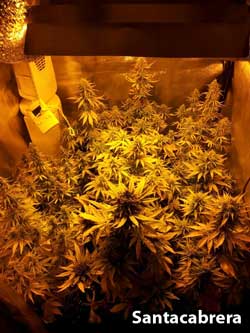
- BioBizz Lightmix Soil
- 11-liter (3 gallon) pots
- Adjustable digital 600W HID grow light (Learn how to set up your exhaust)
- pH + PPM meter or pH Test Kit (uses drops)
Low to Medium Nutrient Needs
Whether you grow in soil, coco coir, or a full hydroponic setup, auto plants tend to prefer relatively low levels of nutrients compared to many other cannabis strains.
When it comes to adding extra bottled nutrients, start at ¼ strength of the recommended dose or less, and only add higher levels of nutrients if needed. In hydro use “vegetative” nutrients until you see the first signs of flowering (pistils / white hairs) around 3-4 weeks. In good soil, you don’t need to add any nutrients during the vegetative stage. After the first signs of buds, start adding “flowering” nutrients at very low strength (¼ or less to start)
View a simple guide to growing autos in soil by Santacabrera
Potted Auto Plants
Potted auto plants tend to do best in an airy potting mix with lots of drainage (plenty of drainage holes, and something like perlite to help add more drainage to your growing medium). This helps makes sure roots get plenty of oxygen so plants grow as fast as possible.
If growing in soil avoid choosing a “hot” (lots of nutrients) soil mix. BioBizz Lightmix soil or Fox Farms Happy Frog are good choices that don’t have too many nutrients to start. With any soil mix, it’s recommended to add about 30% extra perlite for increased drainage.
Read more about a simple soil grow guide for autos
How I use coco coir to get faster growth than soil
Size & How to Control Height of Auto-Flowering Plants
The final size of your auto plants is largely dependent on the strain you get. Some strains, such as Lowryders, have been bred to grow extremely short – less than 1-2 feet. Other strains can grow taller, up to 4 feet tall or even more.
As a general rule of thumb, auto plants tend to double or triple in size from when they first start showing signs of flowering/budding (usually when plants are about 3 weeks old from seed).
There are also some plant training methods that are effective for giving you more control over the final size and shape of your auto-flowering plants.
The most important thing to remember with autos is to avoid using any plant training method that involves cutting the plant. When reading about cannabis training techniques that involve cutting the plant such as topping, FIMing, or main-lining, please remember that these techniques were developed for photoperiod plants and are not well-suited to auto-flowering strains.
Instead, the best way to control height and size with autos is to use low stress training (LST) which involves bending tall branches and using gardening wire or soft ties to hold down the branches.
Here’s a great LST example by Santacabrera showing how to gently bend the middle colas of an auto-flowering plant down and away from the center without cutting or harming the plant.
Bend too-tall branches down and away from the center of your plant
When growers LST auto-flowering strains of cannabis, the general idea is to gently pull branches away from the middle of the plant, so that the plant looks like a star when viewed from above. This helps expose the lower branches to more light, while also keeping plants short. It’s important to only bend stems that are young when they’re still soft and flexible. Older stems become woody and hard to bend.
This technique can be used on auto plants that are getting too tall for your setup, or for any stem that is growing taller than all the others. Most indoor growers want to keep a flat, even canopy when growing indoors to get the most from their grow lights.
Best Light Schedule for Autos
Most indoor growers report getting great growth rates when keeping light schedules on an 18/6 light schedule (18 hours of light and 6 hours of dark each day). 20/4 is another popular light schedule for indoor auto plants. Some growers will give 24 hours of light to auto plants, but others believe that auto plants develop better when given at least a few hours of darkness each day.
When growing autos outdoors, basically you just want to give your plants as much direct sunlight as you can each day. Other than that, you don’t need to worry about light schedules When growing outdoors, more hours of direct sunlight = bigger yields. It is almost impossible to give plants too much light when growing outdoors (as long as heat is under control).

